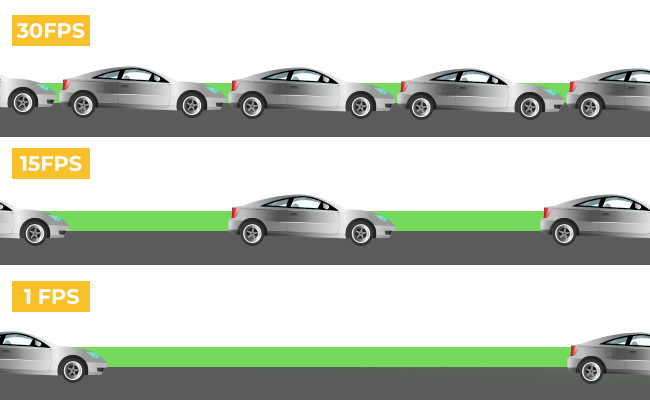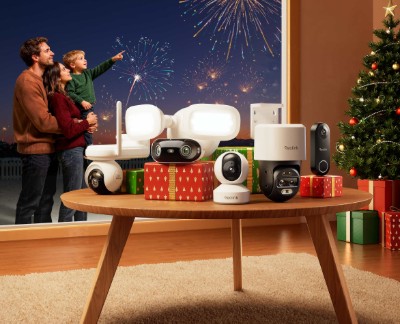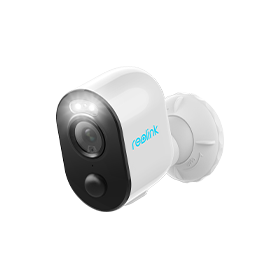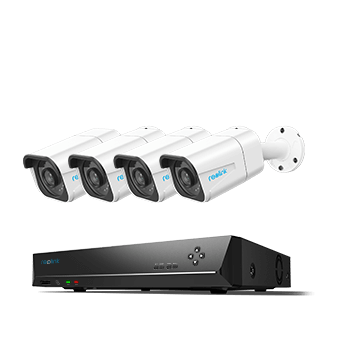Security Camera Frame Rate: 2026 Full Guide

When shopping for security cameras, it is very easy to get distracted by fancy specification details without understanding their meanings. For instance, a camera’s frame rate is a crucial feature but do you really need the highest option available?
This guide will explain what frame rate means, compare the three standard camera frame rates, and make suitable security camera recommendations based on frame rate. Keep reading to learn more!
Reolink New Year Sale - Save Big with Exclusive Deals!
Save big with Reolink! New Year Sale up to 45% off on security cameras, doorbells, and systems — Dec. 8 to Jan. 4.
Basics of Frame Rate
Frame rate, measured in frame per second (FPS), refers to the number of frames or individual images captured by a camera per second.
The frame rate determines the smoothness and fluidity of video playback and is crucial in capturing important details in real-time surveillance scenarios. Basically, cameras with high frame rates produce smoother footage, while cameras with lower frame rates produce videos that look choppy.
Fun fact:
Some experts suggest the human eye can discern details at 30 to 60 frames per second.
Standard Camera Frame Rates
Modern cameras offer a wide range of frame rate options, providing flexibility in capturing videos at different speeds. These options can range from the traditional 24 frames per second (fps) to incredibly high frame rates like 240fps found in some cameras.
24fps: This is the minimum frame rate required for cameras to capture video while still representing realistic motion. It is also the gold standard for cinema and movie production.
30fps: The frame rate for live TV or soap operas is typically 30 fps. This slightly higher frame rate compared to the 24fps provides a smoother feel to the visuals, which is well-suited for the dynamic and fast-paced nature of live TV programming.
60+fps: This and higher frame rates (120fps, 240fps) are used for recording in situations where many quick movements are happening, such as sports events and video games. It is also used in capturing slow-motion videos.
What is the Best Frame Rate for a Security Camera?
The best frame rate for security cameras is 30fps; however, between 15 and 30fps is also acceptable.
Below we discuss how effective standard frame rates are for security surveillance.
15 fps for security camera
While 15fps is not the best frame rate for security surveillance, it still does an adequate job.
A 15fps camera means the device captures and replays footage at 15 consecutive images every second. The resulting footage looks choppier at this speed than footage with a higher frame rate.
This frame rate also falls short in recording fast-paced situations. Quick movements will appear blurry and less detailed in videos. However, in slower-paced cases, 15fps can still do an okay job.
On the plus side, 15fps can be an economical option, and they also require less storage space and bandwidth compared to higher frame rates. You may want to consider this if you are working on a tight budget or with a large-scale surveillance system requiring multiple cameras.
The resolution of the camera can impact its performance at this frame rate. Lower-resolution cameras, such as 720p and 1080p, can maintain good image quality and clarity at 15 fps. However, higher-resolution cameras, such as 4K, may experience a reduction in smoothness and detail, but they can still provide usable footage.
30 fps for security camera
30fps is recognized as the standard frame rate for recording stock footage. This high frame rate provides smoother video playback and allows for capturing motion with better detail.
A 30fps camera can record quick motion better without being affected by blurriness compared to lower frame rates. This makes them effective in fast-paced environments where real-time surveillance is critical.
The major downside to 30fps is that it requires more storage space and bandwidth to accommodate the larger footage size.
60 high fps for security camera
Although not a common choice, 60fps cameras are also used for security surveillance.
Due to their very high frame rates, they are handy in very high-paced environments. For instance, they are used in casinos and stadiums where things are always rowdy. They are also valuable in security cameras that are used to capture moving vehicle license plates.
60fps cameras allow situation footage to be analyzed meticulously with great detail.
A surveillance system with several 60fps cameras can be highly demanding regarding network resources and storage space. A common way to minimize this is to customize the cameras to reduce frame rates when there is no motion and switch back to high frame rates when motion is detected.
It is worth noting that many people cannot visually differentiate between 30fps and 60fps, but the latter offers way more detail when slowed down.
Difference Among 15fps, 30fps, and 60fps
The differences between 15fps, 30fps, and 60fps lie in the motion smoothness, level of detail, and bandwidth/storage requirements. Below is a breakdown of the differences:
15fps
Smoothness: At such a low frame rate, playback of the recorded video looks jerkier than at higher frame rates.
Detail: 15fps struggles in fast-paced scenes. Quick movements will appear blurry and less defined at this frame rate.
Bandwidth & storage requirement: Since this frame rate produces less detail, video file sizes are usually smaller and require less bandwidth.
30fps
Smoothness: 30fps produces natural, smooth movement in videos. It is considered the standard fps for several applications.
Detail: Compared to lower frame rates, 30fps captures more detail in recorded videos. Motion blur is less noticeable, and you can identify features better in fast-moving subjects.
Bandwidth & storage requirement: 30fps requires more storage space and higher bandwidth than lower frame rates due to the more significant amount of data generated.
60fps
Smoothness: Cameras with 60fps and higher frame rates show the smoothest movement possible in videos. However, many may be unable to tell the difference compared to 30fps.
Detail: 60fps shows the most detail in recorded videos. Motion blur is also almost non-existent.
Bandwidth & storage requirement: 60fps will often eat through storage space and network resources at an exponential rate. Video file sizes are enormous and require significantly ample storage space.
Below is a table comparing all three frame rates:
15fps vs 30fps vs 60fp comparison video
Watch this video created by biscuitsalive to find differences in these three frame rates:
Factors to Consider When Picking Security Camera Frame Rates
When selecting the frame rate for a security camera, it is essential to take into account certain factors, including:
-
Application: Determine what you want to use the camera for. In situations where you need real-time surveillance for a fast-paced environment, high frame rate cameras (60fps) are your best bet. On the other hand, low frame rate cameras are viable in places with little or no movement, e.g. parking lots.
-
Bandwidth and storage requirements: The higher the camera’s frame rate, the more demanding it is in terms of bandwidth and storage space. Before picking a camera, consider your available resources and ensure they are sufficient for your choice.
-
Price: Higher frame rate cameras tend to be more expensive. Keep this in mind so you avoid overspending on a camera that is overqualified for your needs.
The Proper Frame Rate Security Camera/ NVR Recommendations
Selecting the right frame rate for security cameras is vital in achieving high-quality surveillance footage. In the following sections, we will provide recommendations to assist you in choosing the most suitable frame rate for your surveillance needs.
2K wireless battery security camera - Argus 3 Pro
Argus 3 Pro | 2K Spotlight Camera Battery/Solar Powered is an affordable yet functional security camera. It boasts a decent 2K resolution with night vision capable of discerning people and vehicles from other objects.
With a frame rate of 15fps, this camera may not be the best option in high-traffic environments, but it is good enough for home and parking lot surveillance.
The Argus 3 Pro wireless powering options (solar and battery-powered) ensure a hassle-free installation process and provide flexibility for the camera placement.
Wire-Free Security Camera with Motion Spotlight
Rechargeable Battery & Solar Powered; Color Night Vision; Outdoor/Indoor Protection; 1080 Full HD; 2-Way Audio and Siren.
4K smart PoE security camera - RLC-811A
RLC-811A | 4K Ultra HD Spotlight PoE Security Camera gives you the best possible image quality on a security camera at 4K resolution, ensuring crystal-clear footage with rich details. With a high resolution and moderate frame rate of 25fps, this camera provides smooth video playback with as much detail as possible.
The 5X optical zoom capability enable you to zoom in on specific areas or objects without sacrificing image quality. This feature is precious when it comes to capturing important details.
4K Smart PoE Camera with 5 Spotlights
4K 8MP Ultra HD Day & Night, Person/Vehicle Alerts, 5X Optical Zoom, Two-Way Audio, Built-in Siren, Color Night Vision, Live View Anywhere.
4K smart PoE security camera system - RLK8-800B4
The RLK8-800B4 is a 4K 8-Channel security camera system. Its mainstream range is 2fps - 20fps, and its substream is 4fps - 15fps. 4k resolution delivers incredibly sharp and detailed video footage. It also offers flexible frame rate options to suit different surveillance scenarios.
Suppose you need to monitor multiple entry points, various rooms, or different areas of your property. In that case, the 8-channel system ensures that you can keep an eye on everything from a centralized location.
4K 8-Channel PoE Security System
4 pcs 4K Ultra HD Security Cameras; 2TB HDD 8-Channel NVR for 24/7 Recording; Person/Vehicle Detection; Plug & Play; 2 Network Solutions.
FAQs
1. Is 15fps good for a security camera?
It depends on where how the camera is applied. When used in areas with minimal quick movements, like warehouses and parking lots, a 15fps camera does an adequate surveillance job.
However, in situations where real-time surveillance is critical, 15fps cameras perform poorly, producing choppy footage.
2. What's the best frame rate for a 4K video?
The best frame rate for a 4K video depends on various factors, such as the intended use, desired visual effect, and audience preferences.
Generally, three standard frame rates are used for 4K video: 24fps, 30fps, and 60fps. 24fps is often chosen for its cinematic quality, providing a more traditional and artistic look suitable for narrative storytelling and movies. 30fps is a standard frame rate used in television, online streaming, and general video content, offering smooth motion and versatility.
On the other hand, 60 fps is preferred for capturing fast-paced action and sports events, delivering enhanced motion detail that can be viewed in slow motion.
3. Can I adjust the frame rate on a security camera?
Yes. Typically, you can access the camera's settings through a web-based interface or dedicated software provided by the manufacturer. You should find options to adjust various parameters, including the frame rate, within the settings.
Conclusion
Whether you are a security professional, a business owner, or a homeowner looking to enhance the security of your premises, understanding the significance of frame rates and making informed decisions about the proper frame rate for your specific requirements is paramount.
We hope you found this post helpful. If you have questions about camera frame rates, share them with us below! Also, don’t hesitate to share this guide with others you think may need it.
Search
Subscribe for the Latest Updates
Security insights & offers right into your inbox




